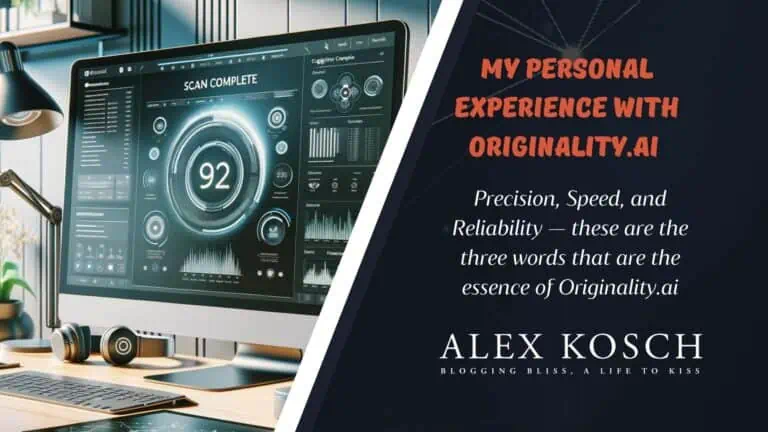
Let’s address the elephant in the classroom, shall we?
Artificial intelligence has arrived in education. Its presence looms large, packing textbooks and homework into its trunk before trampling academic integrity underfoot.
Educators everywhere face a moment of truth: to detect or not detect?
Some cling desperately to a bygone era, refusing to acknowledge the AI elephant at all. Others hop on board, letting the elephant run wild across campus.
But most sense the quaking footsteps headed their way. They know action must be taken before the elephant wreaks havoc. For these vigilant few, AI detection has become an absolute necessity.
Why? you may ask.
Fair question. Many benefits of AI seem too good to pass up. Need an essay fast? Poof! AI can whip one up lickety-split. Struggling in calculus? Let AI work those problems with machine precision.
With a tap or click, AI offers speed and convenience educators have never known. Tempting, isn’t it?
But don’t be fooled. Behind the mesmerizing tricks lies an untamed beast with the potential to trample your students’ education through plagiarism, lack of context, bias, and more.
Detection is the only way to rein it in. To uphold ethics. To nurture creativity. And to instill the critical thinking skills students desperately need to thrive in life after graduation.
Still not convinced? Allow me to persuade you. Today I lay bare the ten undeniable facts that prove AI detection is non-negotiable for educators.
Fact #1: AI encourages rampant cheating

Let’s not sugarcoat this. Students will cheat if given the chance.
Enter AI, ready and willing to compose entire essays and homework assignments from scratch. Left unchecked, it fosters cheating on an unprecedented scale.
Some argue AI merely assists students. But make no mistake: feeds enough prompts to ChatGPT and out pops a full-fledged paper bearing little resemblance to a student’s own work.
This undermines learning. Worse, it wrecks academic integrity, leaving educators powerless to accurately assess students’ abilities.
AI detection helps turn the tide. It flags work unlikely to be original, allowing educators to confront cheating head-on.
Without it, get ready to hand A’s to bots while hardworking students get left behind.
Fact #2: AI lacks nuance

Human writing brims with nuance. It relays complex ideas and emotions that sway readers through subtlety, wit, irony, and grace.
AI knows none of this. It mimics human writing but misses the mark.
Subtly becomes obliviousness. Wit devolves into nonsense. Irony floats right over AI’s head. As for grace…let’s just say AI hits like a sledgehammer.
Such deficiencies become glaring in longer pieces. AI gushes forth verbose content devoid of nuance, exposing its limitations.
But students pass off this clumsy imitation as their own articulate work. Detection lays bare the ruse, alerting educators to writing that lacks human nuance.
Because while AI can certainly generate passable text, it cannot replicate the finesse of an authentic student voice.
Fact #3: AI cannot learn

Learning requires difficulty. It demands deep engagement with course material, iterative practice, and regular feedback. Students learn by doing.
AI learns nothing. It mimics without comprehension, spitting back answers without acquiring skills.
Left to their own devices, students will outsource assignments to AI, depriving themselves of the struggle so vital to education.
Detection clues educators in to which work required true thought and which merely parroted AI. They can then adjust instruction to ensure students get the practice they need.
Because handing learning over to AI? That helps no one in the long run. Education is far too precious to automate away.
Fact #4: AI lacks context

AI operates devoid of context. Without lived experiences or individualized learning, its responses float in an airless vacuum.
Students, however, come to school with unique contexts that shape how they process material. Their perspectives differ, colored by upbringing, culture, interests, and prior education.
When students rely on AI, their writing becomes detached from the personal contexts that normally enrich their work with purpose and passion.
Detection alerts educators when content seems to lack the individual perspective that grounds student work. This context gap signals AI dependency, allowing educators to re-center learning around the student.
Because while AI spits out generic, cookie-cutter text, real education must remain tailored to the student context.
Fact #5: AI has no quality control

Think AI always generates perfect content? Think again. Behind its veneer of intelligence lurk plenty of boneheaded blunders.
Pressed to create longer works, AI rambles off course. Fill a prompt with biases and it obliges. Feed it faulty data and it happily parrots misinformation.
Its seeming eloquence quickly erodes into irrelevant tangents, distorted reasoning, and absurd claims pulled straight from the ether.
Students then present these garbled messes as their own work. But detection quickly exposes when an assignment goes off the rails, allowing educators to steer students back towards quality.
Because educators must uphold standards. And AI, for all its computing power, cannot discern quality from quackery.
Fact #6: AI stifles creativity

Real education cultivates creativity. It empowers students to look at the world through a unique lens, generating ideas and expressions that push boundaries.
AI cannot create. It only regurgitates, recombining input it’s already been given into a thin veneer of novelty.
In the process, it hijacks the creative opportunities that allow students to grow. Imagination atrophies when original thought gets outsourced.
Detection clues educators in to writing produced via AI recombinance rather than human creativity. They can then develop assignments that re-engage creativity and empower students to share their unique inner worlds.
Because handing creativity over to AI? That’s giving away the keys to innovation and self-expression.
Fact #7: AI breeds dependence

At first, tapping AI for homework help seems harmless. But overreliance breeds dependence.
Students forget how to study. How to incrementally build skills. How to power through confusion and self-correct errors.
Instead, they cling to AI like a crutch, letting it think and write while their own skills stagnate.
But the real world offers no crutch. It demands grit, persistence, and the ability to think independently.
Detection alerts educators when students go from using AI as a tool to depending on it entirely. Intervention can refocus learning on building lasting skills rather than chasing quick fixes.
Because if students depend on AI now, what will they do when left to think for themselves?
Fact #8: AI cannot comprehend

True comprehension requires connecting disparate ideas, unpacking nuance, and distilling concepts into unique perspectives.
AI merely regurgitates. Trained on data, it makes impressive yet superficial associations that mimic comprehension without actually achieving it.
Students then present these hollow imitations as demonstrative of deep engagement with course material.
But detection lays bare the illusion, flagging work that demonstrates comprehension only on a surface level. Educators can then push students towards the deeper understanding that marks true learning.
Because AI cannot be allowed to dummy down discourse. Education demands rigorous thought and examination.
Fact #9: AI has ethical implications

AI does not exist in a vacuum. It impacts how people think, act, and view the world.
Educators have a responsibility to probe these implications with students. To discuss ethics openly. To cultivate future innovators who wield AI conscientiously.
But students blindly copying AI evade these vital conversations. They treat AI merely as a tool rather than grappling with its profound influence on society.
Detection clues educators in to who is thoughtfully engaging with AI and who is recklessly parroting it. They can then target discussions to ensure all students grasp AI’s ethical dimensions.
Because classrooms must tackle technology’s ethical quagmires, not ignore them. Students deserve that discernment.
Fact #10: Quality education demands authenticity

In the end, allowing AI to infiltrate education undermines authentic scholarship.
Educators owe students an honest appraisal of their abilities. Employers and colleges expect applicants shaped by rigorous, individualized learning, not AI regurgitation.
Maintaining these standards means upholding academic integrity and requiring students to demonstrate comprehension, creativity, contextualized thought, and communication skills they can claim as their own.
Detection defends authenticity. It ensures educators can still evaluate students on merit. That employers still get candidates shaped by real education, not AI imitation.
Without it, what worth remains in student work? Degrees devoid of merit help no one.
The facts don’t lie. AI detection is non-negotiable for quality education. Educators who deny this do so at their peril, sacrificing student potential to facile AI shortcuts.
The elephant looms large. There’s no avoiding it. But we still have time to grab those detectors before it stamps out academic integrity for good.
So wield those tools. Empower students with skills that far outlast surface-level AI. And let’s keep education where it belongs: in human hands equipped to wield technology conscientiously, creatively, and ethically.
Our students deserve no less. The future demands it.

About the Author
Meet Alex Kosch, your go-to buddy for all things AI! Join our friendly chats on discovering and mastering AI tools, while we navigate this fascinating tech world with laughter, relatable stories, and genuine insights. Welcome aboard!
KEEP READING, MY FRIEND






